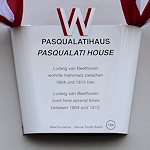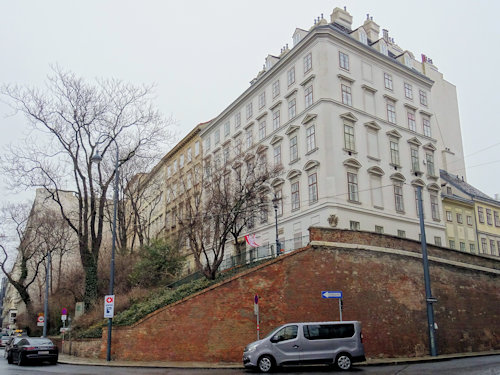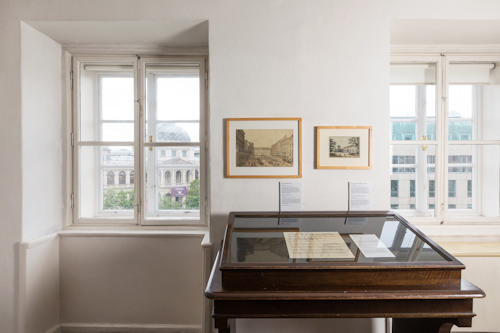
The Pasqualatihaus house once echoed to the works of Beethoven played by the composer himself.
You might say the same of many Viennese buildings (Beethoven moved around a lot), but here you can actually visit a suite of memorial rooms inside.
- Small “museum” in a house Beethoven lived in for many years
- Few original items: more of a homage and memorial
- Book a concert experience* for Vienna
- See also:
- Beethoven locations in Vienna
- One-time free entry with the Vienna All-Inclusive Pass
Inside the Pasqualatihaus

(In the past, the house view would have looked across to open fields and villages)
The house owner – Baron Pasqualati – was a friend and sponsor of Beethoven, and the composer lived in one of the apartments within at various times between 1804 and 1814.
Here the great man worked on, for example, the opera that became known as Fidelio, several symphonies, and the famous Für Elise piano piece that even an idiot like me recognizes.
What Beethoven did not do was live in the exact same rooms you can visit. Though he did live on the same floor.
So manage your expectations; this is not a former apartment or a comprehensive Beethoven museum (that’s here and highly recommended), but a kind of small homage and memorial to the composer.
The house sits on a raised site above the old city walls, and would have looked down across the green suburbs of Vienna. It must have been an inspiring location for anyone with a creative bent.
Stand by the window and let your imagination roam free to get a feel for the environment that Beethoven composed in.
(You need your imagination because the countryside and small villages from Beethoven’s time have long given way to city expansion.)
The area still retains its historical ambience, which is why it appears in various film and TV productions.
For example, they used the surrounding streets for outdoor scenes in the Vienna Blood period crime series.
Harry Lime made his first appearance in The Third Man just a couple of doors down. Jesse and Céline chatted their way through the area in Before Sunrise. And a young Maria Altmann sprinted up the road outside as she ran from her Nazi pursuers in The Woman in Gold.
The five rooms inside the Pasqualatihaus are small and unfurnished. In each, you’ll find a handful of items and displays relating to Beethoven’s life or work. But it’s all fairly minimalist.

(Exhibition view; press photo by Lisa Rastl and © Wien Museum)
Only a couple of original Beethoven possessions grace the location: a salt and pepper pot, for example, though that’s still kind of endearing to see. Otherwise, it’s pictures of performers and other contemporaries, opera flyers of the time, an oil portrait, a bust, and similar.
Unfortunately, most of the display information was in German on my visit, so it was hard to get much from it all unless you already knew your Beethoven. (This might have changed since, of course.)
I did enjoy seeing some sheet music with his corrections, but all inevitably copies given their value and delicacy. You can also listen to selected Beethoven works at music desks.
In summary: worth a visit if you’re tracing Beethoven’s footsteps across the city and immersing yourself in his life and works. Otherwise, it probably won’t feature at the top of your sightseeing list.

(Photograph by August Stauda of the Mölker Bastei, Pasqualatihaus and Liebenberg monument; view from Universitätsring around 1904–1905; Wien Museum Inv.-Nr. 29468; excerpt reproduced with permission under the terms of the CC0 licence)
Tickets & visitor tips
At the time of writing, adult tickets were €5. A Go City Vienna All-Inclusive Pass (see my review) also covers the Pasqualatihaus and many other former musician residences managed by the excellent Wien Museum.
Note that you need to climb several sets of stairs inside the house to reach the museum. (Vienna is very accessible, but sometimes you can’t put a lift in very old buildings.)
If you want to continue the Fidelio connection, look to the Theater an der Wien. The piece premiered there (as did other Beethoven compositions and works by the likes of Schubert and Johann Strauss II).
You may also notice a large 1890 monument in front of the Pasqualatihaus.
Despite the location, the column and golden figure has nothing to do with Beethoven. The ensemble commemorates Johann Andreas von Liebenberg: the Mayor of Vienna during the 1683 Ottoman siege.
How to get to the Pasqualati House
The house is just off the main Ring boulevard, so quite central. Stand on the Ring at the Liebenberg monument and look up and toward the city center: you’ll see it above you.
This section of Vienna is actually on my recommended self-guided walking tour route (in part 4).
The building lies just a hop, skip, and a jump from Schottentor station, reachable via the U2 subway line and serving various tram (1, 37, 38, 40, 41, 42, 43, 44, 71, D) and bus (1A and 40A) lines.
When you leave Schottentor, head south along the ring on the city center side: it’s just around 200m away.
Address: Mölker Bastei 8 , 1010 Vienna | Website